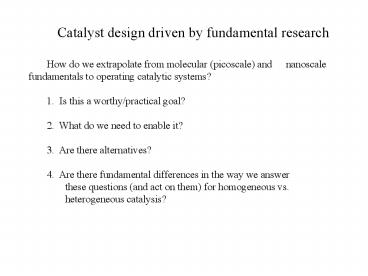Catalyst design driven by fundamental research - PowerPoint PPT Presentation
1 / 11
Title:
Catalyst design driven by fundamental research
Description:
Enable catalyst design through combined experimental and mechanistic ... Catalyst design = ability to specify and synthesize catalysts to achieve ... – PowerPoint PPT presentation
Number of Views:136
Avg rating:3.0/5.0
Title: Catalyst design driven by fundamental research
1
Catalyst design driven by fundamental research
How do we extrapolate from molecular
(picoscale) and nanoscale fundamentals to
operating catalytic systems? 1. Is this a
worthy/practical goal? 2. What do we need to
enable it? 3. Are there alternatives? 4.
Are there fundamental differences in the way we
answer these questions (and act on them) for
homogeneous vs. heterogeneous catalysis?
2
Vision 2020 Catalyst Technology Roadmap (1997)
- Primary Needs
- Enable catalyst design through combined
experimental and mechanistic understanding, and
improved computational chemistry. - 2. Development of techniques for high throughput
synthesis of catalysts and clever new assays for
rapid throughput catalyst testing, potential
combinatorial techniques, and reduction of
analytical cycle time by parallel operation and
automation. - 3. Better in situ techniques for catalyst
characterization - 4. Synthesis of catalysts with specific site
architecture
3
- Catalyst design ability to specify and
synthesize catalysts to achieve desirable
chemical transformations - Translate molecular (picoscale) and nanoscale
fundamentals to catalyst design at this length
scale - Catalyst design driven by fundamental research
is the exception rather than the norm.
4
Examples of success in catalyst design driven by
fundamental research
- From understanding known catalysts to inventing
new ones - Translating understanding of ceria function in
3-way exhaust catalysts into new water-gas-shift
catalysts - New supported oxide monolayer catalysts for
alcohol oxidation - Selective catalytic oxidation of benzene to
phenol using nitrous oxide
5
Examples of success in catalyst design driven by
fundamental research
- Ligand design in homogeneous catalysis
- Single Site olefin polymerization catalysts
- Enzyme analogs synthetic di-iron complexes that
mimic hydrogenases
6
Examples of success in catalyst design driven by
fundamental research
- Catalyst design from first principles Theory
and Experiment - Gold-Nickel steam reforming catalyst
- Bimetallic ammonia synthesis catalyst
- Oxide catalysts for selective ketene synthesis
7
Central Themes and ConceptsKey characteristics
of successes
- Recognition of reactivity patterns
- Close interaction of theory and experiment
- Synthesis and testing of designs
- Multidisciplinary approaches/ multidisciplinary
collaborations
8
Critical needs
- Better understanding of molecular level
mechanisms - Better access to synthetic capabilities
- Better ways of creating models of working
catalysts - Better understanding of attributes that make for
successful scale-up - (Better communication/collaboration)
- Fundamental studies of the thermodynamics of
bonds - Catalysis Informatics
- Materials structure of complex systems from atom
connectivity to physical, chemical and electronic
properties - New ligand platforms
- New supports
- New reaction environments
- (Dynamics of elementary processes)
9
Goals, Challenges and Opportunities
- Vision 2020 technology targets remain relevant
- Selective oxidation
- Alkane activation
- Byproduct and waste minimization
- Stereoselective synthesis
- Functional olefin polymerization
- Alkylation
- Living polymerization
- Alterative feedstocks and renewables
- Additions to this list
- Photocatalytic water splitting
- Low cost oxidants
- NO decomposition
- Methane conversion to useful products
- Clean transportation fuels
- Fuel cells
- Replacement of Pt-group metals
- New materials that embody nanoscale control of
structure and chemical function
10
Frontiers in Chemical Engineering (1988)
With sufficient development of theoretical
methods, it should be possible to predict the
desired catalyst composition and structure to
catalyze specific reactions prior to formulation
and testing of new catalysts.
11
Opportunities in Chemistry (1985)
We propose an initiative to apply the techniques
of chemistry to obtain a molecular-level and
coherent understanding of catalysis that
encompasses heterogeneous, homogeneous, photo-,
electro-, and artificial enzyme catalysis.

